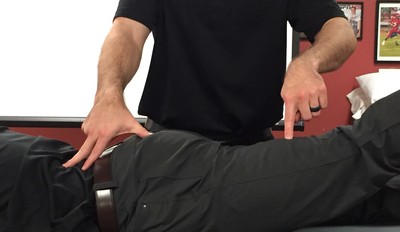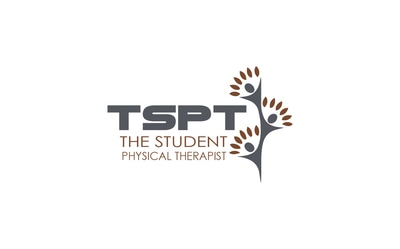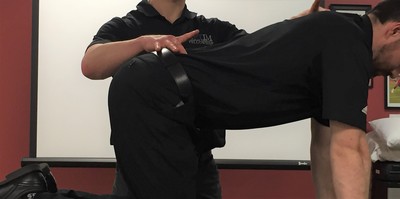- Home
- About Us
- TSPT Academy
- Online Courses
-
Resources
- Newsletter
- Business Minded Sports Physio Podcast
- Day in the Life of a Sports PT
- Residency Corner
-
Special Tests
>
-
Cervical Spine
>
- Alar Ligament Test
- Bakody's Sign
- Cervical Distraction Test
- Cervical Rotation Lateral Flexion Test
- Craniocervical Flexion Test (CCFT)
- Deep Neck Flexor Endurance Test
- Posterior-Anterior Segmental Mobility
- Segmental Mobility
- Sharp-Purser Test
- Spurling's Maneuver
- Transverse Ligament Test
- ULNT - Median
- ULNT - Radial
- ULNT - Ulnar
- Vertebral Artery Test
- Thoracic Spine >
-
Lumbar Spine/Sacroiliac Joint
>
- Active Sit-Up Test
- Alternate Gillet Test
- Crossed Straight Leg Raise Test
- Extensor Endurance Test
- FABER Test
- Fortin's Sign
- Gaenslen Test
- Gillet Test
- Gower's Sign
- Lumbar Quadrant Test
- POSH Test
- Posteroanterior Mobility
- Prone Knee Bend Test
- Prone Instability Test
- Resisted Abduction Test
- Sacral Clearing Test
- Seated Forward Flexion Test
- SIJ Compression/Distraction Test
- Slump Test
- Sphinx Test
- Spine Rotators & Multifidus Test
- Squish Test
- Standing Forward Flexion Test
- Straight Leg Raise Test
- Supine to Long Sit Test
-
Shoulder
>
- Active Compression Test
- Anterior Apprehension
- Biceps Load Test II
- Drop Arm Sign
- External Rotation Lag Sign
- Hawkins-Kennedy Impingement Sign
- Horizontal Adduction Test
- Internal Rotation Lag Sign
- Jobe Test
- Ludington's Test
- Neer Test
- Painful Arc Sign
- Pronated Load Test
- Resisted Supination External Rotation Test
- Speed's Test
- Posterior Apprehension
- Sulcus Sign
- Thoracic Outlet Tests >
- Yergason's Test
- Elbow >
- Wrist/Hand >
- Hip >
- Knee >
- Foot/Ankle >
-
Cervical Spine
>
- I want Financial Freedom
- I want Professional Growth
- I want Clinical Mastery
Sign of the Buttock
Purpose: To determine the possibility of non-musculoskeletal causes for the patient's symptoms.
Test Position: Supine.
Performing the Test: A straight leg raise is performed passively by the examiner (the patient cannot usually perform an active SLR). If the SLR is positive, the end-feel is usually spasm or capsular, but definitely painful. Return the patient to neutral. Passively flex the patient's hip, but this time with the ipsilateral knee flexed to end-range. Assess for if further hip flexion was achieved. If no change in range of motion, the pathology is within the hip or buttock, and not the hamstrings or sciatic nerve. The second part of the test usually has an empty end-feel and is more painful than the first part. To be positive, the Sign of the Buttock must have all present: restriction of SLR concurrently with limited hip flexion and a non-capsular pattern of restriction of hip joint ROM.
Diagnostic Accuracy: Unknown.
Importance of the Test: When performing a SLR, a pathology in the hamstrings, sciatic nerve, buttock, or hip may cause limitations. If the knee is flexed, the stress is taken off the hamstrings and sciatic nerve (because they cross the knee), so remaining limitation is due to pathology of the hip or buttock. With an empty end feel, we know that there is a potentially serious pathology involved in the patient's symptoms, which may include: osteomyelitis, chronic septic SI arthritis, ischiorectal abscess, septic bursitis, neoplasm of the upper femur, or fractured sacrum.
Note: these tests should only be used by properly trained health care practitioners.
Test Position: Supine.
Performing the Test: A straight leg raise is performed passively by the examiner (the patient cannot usually perform an active SLR). If the SLR is positive, the end-feel is usually spasm or capsular, but definitely painful. Return the patient to neutral. Passively flex the patient's hip, but this time with the ipsilateral knee flexed to end-range. Assess for if further hip flexion was achieved. If no change in range of motion, the pathology is within the hip or buttock, and not the hamstrings or sciatic nerve. The second part of the test usually has an empty end-feel and is more painful than the first part. To be positive, the Sign of the Buttock must have all present: restriction of SLR concurrently with limited hip flexion and a non-capsular pattern of restriction of hip joint ROM.
Diagnostic Accuracy: Unknown.
Importance of the Test: When performing a SLR, a pathology in the hamstrings, sciatic nerve, buttock, or hip may cause limitations. If the knee is flexed, the stress is taken off the hamstrings and sciatic nerve (because they cross the knee), so remaining limitation is due to pathology of the hip or buttock. With an empty end feel, we know that there is a potentially serious pathology involved in the patient's symptoms, which may include: osteomyelitis, chronic septic SI arthritis, ischiorectal abscess, septic bursitis, neoplasm of the upper femur, or fractured sacrum.
Note: these tests should only be used by properly trained health care practitioners.
Copyright © The Student Physical Therapist LLC 2023




